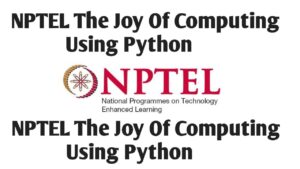Nptel The Joy of Computing Using Python Week 3 Assignment Answers
Searching for the Week 3 answers of the Nptel The Joy of Computing Using Python course? You’re in the right spot! Here, you’ll find reliable and up-to-date solutions to help you complete your Week 3 assignment with confidence.

The Joy of Computing using Python
ABOUT THE COURSE :
INTENDED AUDIENCE : Any interested audience
PREREQUISITES : 10th standard/high school
INDUSTRY SUPPORT : Every software company is aware of the potential of a first course in computer science. Especially of a first course in computing, done right.
COURSE LAYOUT – Click To Know More
- Motivation for Computing
- Welcome to Programming!!
- Variables and Expressions : Design your own calculator
- Loops and Conditionals : Hopscotch once again
- Lists, Tuples and Conditionals : Lets go on a trip
- Abstraction Everywhere : Apps in your phone
- Counting Candies : Crowd to the rescue
- Birthday Paradox : Find your twin
- Google Translate : Speak in any Language
- Currency Converter : Count your foreign trip expenses
- Monte Hall : 3 doors and a twist
- Sorting : Arrange the books
- Searching : Find in seconds
- Substitution Cipher : What’s the secret !!
- Sentiment Analysis : Analyse your Facebook data
- 20 questions game : I can read your mind
- Permutations : Jumbled Words
- Spot the similarities : Dobble game
- Count the words : Hundreds, Thousands or Millions.
- Rock, Paper and Scissor : Cheating not allowed !!
- Lie detector : No lies, only TRUTH
- Calculation of the Area : Don’t measure.
- Six degrees of separation : Meet your favourites
- Image Processing : Fun with images
- Tic tac toe : Let’s play
- Snakes and Ladders : Down the memory lane.
- Recursion : Tower of Hanoi
- Page Rank : How Google Works !!
Nptel The Joy of Computing Using Python Week 3 Assignment Answers
1) Which of the following is/are false statement(s)?
a) Lists are fixed in size; they cannot store more than 1024 values.
b) One can access elements in a list using non-numeric indices.
c) Iterating over lists is possible in Python.
d) We need to specify the required size of a list while creating a new list variable.
View Answer
2) In the below code:
for i in range(n):
l1 = []
for j in range(i):
l1.append(j)
for k in l1:
a.append(p)
for l in a:
print(k)
For what value of n does the program print 10?
View Answer
3) From the previous question, for what values of nn is the number 25 appended to list aa?
a) 25
b) 24
c) 35
d) 32
View Answer
4) What does the following code perform?
def mystery(container):
result = []
for i in range(len(container)):
result.append(container[i])
else:
result.append(container[1])
return result
a) It converts any input list into a new list which is filled with some numbers that are always in increasing order.
b) It converts any input list into a new list such that at even indices, the value is a multiple of an even number and at odd indices, the value is either even or a negative number.
c) It converts any input list into a new list such that at odd indices, the value is always an even number and at even indices, the value is negative.
d) It converts any input list into a new list, which follows no pattern.
View Answer
For Latest Update Join our official channel: Click here to join
5) From the previous question, if the option:
“It converts any input list into a new list such that at even indices, the value is a multiple of an even number and at odd indices, the value is either even or a negative number.”
is incorrect, can you make changes to the code so that this option is always true for any input?
a) No, it is not possible to make such changes.
b) No, the option is already correct.
c) Yes, we can make changes.
View Answer
6) If file.txt exists, does the following code successfully run?
with open("file.txt", "r") as f:
data = f.read()
print(data)
a) Yes
b) No
View Answer
7) Which of the following are examples of Social Computing?
a) ChatGPT
b) Wikipedia
c) Quora
d) Twitch
View Answer
8) What does the following code print for n=2560n = 2560?
n = 2560
while n:
a.append(n % 10)
n //= 10
a.sort()
for i in a:
if b:
print("PYTHON IS FUN")
else:
print("PYTHON IS BORING")
a) PYTHON IS BORING
b) PYTHON IS FUN
View Answer
For Latest Update Join our official channel: Click here to join
9) From the previous question, is a.sort() responsible for printing either of the two possible sentences?
a) Yes, and the code may print “PYTHON IS FUN”.
b) No, it is purely dependent on variable nn.
c) No, it is not dependent on a.sort(), and the code will never print “PYTHON IS FUN”.
View Answer
10) What does the code in question 8 calculate?
Can you determine the values of kk and bb if: n=245326785456×103359n = 245326785456 \times 103359
If the values of kk and bb are different, enter 0; else, enter the value of kk.
View Answer
Nptel The Joy Of Computing Using Python Week 4 Assignment Answers – Click Here